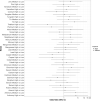Low levels of salivary metals, oral microbiome composition and dental decay
- PMID: 32887894
- PMCID: PMC7474081
- DOI: 10.1038/s41598-020-71495-9
Low levels of salivary metals, oral microbiome composition and dental decay
Abstract
Salivary microbiome composition can change following exposure to environmental toxicants, e.g., heavy metals. We hypothesized that levels of salivary nutrients and metals would correlate with salivary microbiome composition and be associated with dental decay. Here we assess the salivary concentrations of 5 essential minerals (cobalt, copper, manganese, molybdenum, and zinc), 4 metals with some evidence of normal physiological function (chromium, nickel, tungsten, and vanadium), and 12 with known toxicity (antimony, arsenic, barium, beryllium, cadmium, cesium, lead, mercury, platinum, thallium, tin, and uranium), and their associations with salivary microbiome composition and dental decay in 61 children and adults. 16 metals were detected in 54% of participants; 8 were found in all. Marked differences in salivary bacterial taxa were associated with levels of antimony, arsenic, and mercury, after adjusting for multiple testing. Further, antimony levels were associated with the presence of decayed teeth. Thus, salivary metal levels, even at low concentrations, may impact oral health.
Conflict of interest statement
The authors declare no competing interests.
Figures
Similar articles
-
[Association between 23 urinary metals and mean platelet volume among a community-dwelling population in Wuhan, China].Zhonghua Yu Fang Yi Xue Za Zhi. 2016 Aug 6;50(8):689-97. doi: 10.3760/cma.j.issn.0253-9624.2016.08.005. Zhonghua Yu Fang Yi Xue Za Zhi. 2016. PMID: 27539521 Chinese.
-
Aluminum, Arsenic, Beryllium, Cadmium, Chromium, Cobalt, Copper, Iron, Lead, Mercury, Molybdenum, Nickel, Platinum, Thallium, Titanium, Vanadium, and Zinc: Molecular Aspects in Experimental Liver Injury.Int J Mol Sci. 2022 Oct 13;23(20):12213. doi: 10.3390/ijms232012213. Int J Mol Sci. 2022. PMID: 36293069 Free PMC article. Review.
-
Combined exposure to multiple metals on cardiovascular disease in NHANES under five statistical models.Environ Res. 2022 Dec;215(Pt 3):114435. doi: 10.1016/j.envres.2022.114435. Epub 2022 Sep 26. Environ Res. 2022. PMID: 36174761
-
Urinary metals and metal mixtures in midlife women: The Study of Women's Health Across the Nation (SWAN).Int J Hyg Environ Health. 2019 Jun;222(5):778-789. doi: 10.1016/j.ijheh.2019.05.002. Epub 2019 May 15. Int J Hyg Environ Health. 2019. PMID: 31103473 Free PMC article.
-
The relative impact of toxic heavy metals (THMs) (arsenic (As), cadmium (Cd), chromium (Cr)(VI), mercury (Hg), and lead (Pb)) on the total environment: an overview.Environ Monit Assess. 2019 Jun 8;191(7):419. doi: 10.1007/s10661-019-7528-7. Environ Monit Assess. 2019. PMID: 31177337 Review.
Cited by
-
Protocol for CARES-HAPIN: an ambidirectional cohort study on exposure to environmental tobacco smoke and risk of early childhood caries.BMJ Open. 2024 May 15;14(5):e083874. doi: 10.1136/bmjopen-2024-083874. BMJ Open. 2024. PMID: 38749682 Free PMC article.
-
Increased risk of attention-deficit/hyperactivity disorder in adolescents with high salivary levels of copper, manganese, and zinc.Eur Child Adolesc Psychiatry. 2024 Sep;33(9):3091-3099. doi: 10.1007/s00787-024-02381-2. Epub 2024 Feb 14. Eur Child Adolesc Psychiatry. 2024. PMID: 38353679 Free PMC article.
-
Effects of long-term metal exposure on the structure and co-occurrence patterns of the oral microbiota of residents around a mining area.Front Microbiol. 2023 Oct 19;14:1264619. doi: 10.3389/fmicb.2023.1264619. eCollection 2023. Front Microbiol. 2023. PMID: 37928665 Free PMC article.
-
Heavy metals in drinking water and periodontitis: evidence from the national oral health survey from China.BMC Public Health. 2023 Sep 4;23(1):1706. doi: 10.1186/s12889-023-16391-3. BMC Public Health. 2023. PMID: 37667326 Free PMC article.
-
Environmental tobacco smoke exposure is associated with increased levels of metals in children's saliva.J Expo Sci Environ Epidemiol. 2023 Nov;33(6):903-910. doi: 10.1038/s41370-023-00554-w. Epub 2023 May 5. J Expo Sci Environ Epidemiol. 2023. PMID: 37147431 Free PMC article.
References
-
- Porcheron G, Garénaux A, Proulx J, Sabri M, Dozois C. Iron, copper, zinc, and manganese transport and regulation in pathogenic Enterobacteria: correlations between strains, site of infection and the relative importance of the different metal transport systems for virulence. Front. Cell. Infect. Microbiol. 2013;3:1. - PMC - PubMed
-
- Luo J, Hein C, Mücklich F, Solioz M. Killing of bacteria by copper, cadmium, and silver surfaces reveals relevant physicochemical parameters. Biointerphases. 2017;12:020301. - PubMed
-
- Centers for Disease Control. Hygiene-related Diseases. Cdc.gov (2019). Available at: https://www.cdc.gov/healthywater/hygiene/disease/dental_caries.html#one (Accessed 21 June 2019)
-
- National Institutes of Health. Periodontal (Gum) Disease. Nidcr.nih.gov (2018). Available at: https://www.nidcr.nih.gov/research/data-statistics/periodontal-disease
Publication types
MeSH terms
Substances
Grants and funding
LinkOut - more resources
Full Text Sources
Medical



